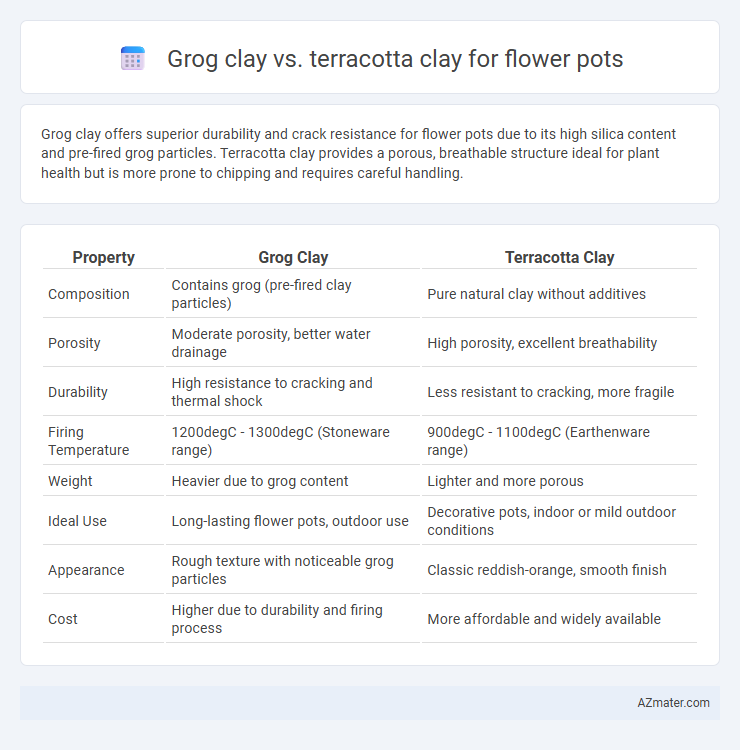Grog clay offers superior durability and crack resistance for flower pots due to its high silica content and pre-fired grog particles. Terracotta clay provides a porous, breathable structure ideal for plant health but is more prone to chipping and requires careful handling.
Table of Comparison
| Property | Grog Clay | Terracotta Clay |
|---|---|---|
| Composition | Contains grog (pre-fired clay particles) | Pure natural clay without additives |
| Porosity | Moderate porosity, better water drainage | High porosity, excellent breathability |
| Durability | High resistance to cracking and thermal shock | Less resistant to cracking, more fragile |
| Firing Temperature | 1200degC - 1300degC (Stoneware range) | 900degC - 1100degC (Earthenware range) |
| Weight | Heavier due to grog content | Lighter and more porous |
| Ideal Use | Long-lasting flower pots, outdoor use | Decorative pots, indoor or mild outdoor conditions |
| Appearance | Rough texture with noticeable grog particles | Classic reddish-orange, smooth finish |
| Cost | Higher due to durability and firing process | More affordable and widely available |
Introduction to Grog Clay and Terracotta Clay
Grog clay contains pre-fired clay particles that enhance strength and reduce shrinkage, making it ideal for durable flower pots that withstand outdoor conditions. Terracotta clay, a porous, unglazed earthenware, offers excellent breathability and natural moisture regulation for healthy plant roots. Both clays have unique properties, with grog clay emphasizing durability and terracotta clay providing natural, earthy aesthetics.
Composition and Material Differences
Grog clay contains pre-fired clay particles or grog that enhance thermal shock resistance and reduce shrinkage, making it ideal for durable flower pots with better structural integrity. Terracotta clay is primarily composed of natural earthenware clay rich in iron oxide, offering a porous material that allows air and moisture exchange but is more fragile compared to grog clay. The inclusion of grog in clay improves strength and reduces cracking, while terracotta's traditional composition results in a more breathable but less mechanically robust flower pot.
Physical Properties: Strength and Porosity
Grog clay offers higher strength and reduced shrinkage, making it more durable and resistant to cracking for flower pots compared to terracotta clay. The presence of grog particles creates a coarser texture that enhances structural integrity while maintaining moderate porosity for water drainage. Terracotta clay has higher porosity, which promotes better aeration but results in lower mechanical strength and increased susceptibility to chipping under stress.
Aesthetic Appeal and Texture
Grog clay offers a rustic aesthetic with a coarse texture due to its granular composition, enhancing natural, earthy flower pot designs suited for outdoor or cottage-style decor. Terracotta clay features a smooth, fine texture and a warm reddish-orange hue, providing a classic and elegant appearance ideal for traditional or Mediterranean-themed flower pots. The choice between Grog and Terracotta clay significantly influences the visual texture and overall artistic appeal of the flower pot, tailoring it to specific decorative preferences.
Water Retention and Drainage Capabilities
Grog clay contains pre-fired particles that create micro-pores, enhancing drainage and preventing waterlogging in flower pots. Terracotta clay is porous, allowing moderate water retention while promoting air circulation to roots, but it can dry out faster than grog clay pots. Choosing grog clay is ideal for plants requiring well-drained soil, whereas terracotta suits those benefiting from balanced moisture and breathability.
Durability and Weather Resistance
Grog clay contains pre-fired clay particles that enhance flower pot durability by reducing cracking and warping under temperature fluctuations. Terracotta clay is porous and prone to absorbing moisture, which can lead to weather-related damage such as frost cracking and erosion over time. Flower pots made from grog clay generally exhibit superior resistance to harsh weather conditions, making them more suitable for outdoor use compared to traditional terracotta pots.
Suitability for Plant Health
Grog clay offers superior drainage and aeration due to its coarser texture, which prevents root rot and enhances oxygen flow essential for healthy plant growth. Terracotta clay is porous and helps regulate moisture but may dry out faster, requiring more frequent watering to maintain optimal soil conditions for plants. The choice between grog and terracotta clay impacts root respiration and water retention, crucial factors influencing overall plant health in flower pots.
Cost Comparison and Availability
Grog clay, infused with pre-fired clay particles, offers enhanced durability for flower pots but often comes at a higher price point compared to terracotta clay, which is widely available and budget-friendly. Terracotta clay's abundant availability in garden centers and pottery suppliers makes it a cost-effective choice for large-scale planting projects. Cost differences hinge on grog content and firing processes, with terracotta preferred for economical, traditional pots while grog clay suits specialized, longer-lasting designs.
Environmental Impact and Sustainability
Grog clay contains pre-fired clay particles that improve strength and reduce shrinkage, allowing for less energy-intensive firing processes compared to terracotta clay, which requires higher temperatures and longer kiln times. The inclusion of grog reduces the overall environmental footprint by minimizing raw material extraction and lowering emissions during production. Terracotta, while biodegradable and made from natural clay, often demands more resources, making grog clay a more sustainable choice for environmentally conscious flower pot manufacturing.
Best Uses: Choosing the Right Clay for Your Flower Pot
Grog clay, enriched with ground fired clay particles, offers superior strength and thermal shock resistance, making it ideal for outdoor flower pots exposed to varying weather conditions. Terracotta clay, known for its porous nature, excels in breathability and moisture regulation, perfect for indoor plants requiring well-drained soil and moderate watering. Selecting grog clay enhances durability and frost resistance, while terracotta clay supports plant health through moisture evaporation, aligning with specific gardening needs.

Infographic: Grog clay vs Terracotta clay for Flower pot
 azmater.com
azmater.com